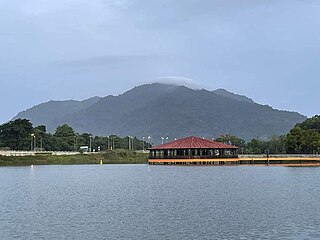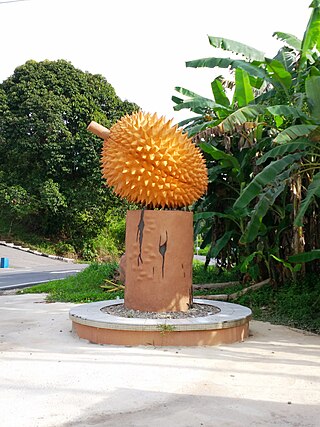
Serian is a town, and the capital of the Serian separated on 11 April 2015 from Samarahan Division, Sarawak, Malaysia. It is located about 40 miles (64 km) from Kuching. Sub-district headquarters towns are Balai Ringin and Tebedu.

Simanggang is a town and the capital of Sri Aman District and Sri Aman Division in Sarawak, east Malaysia. Located on the Lupar River, it is 193 kilometres (120 mi), a three-hour drive, from Kuching, the capital of Sarawak. It is a trade center for the timber, oil palm, rubber, and pepper of its mostly agricultural district.

Lawas is a small town and the capital of Lawas District, Limbang Division, Sarawak, Malaysia. This district area is 3,811.90 square kilometres, and population was 46,200. It is 1,200 km from the state capital, Kuching and 200 km from the capital city of Sabah, Kota Kinabalu.

Tatau is a town, and the capital of the Tatau District in Bintulu Division, Sarawak, Malaysia. The district's reported total population for Tatau was 30,383. Tatau became a district in 1987. Before that it was a Sub District under Bintulu District. The main spoken languages are Iban, Kenyah, Beketan and Punan.
Saratok is a town, and the capital of the Saratok District in Betong Division, Sarawak, East Malaysia in the island of Borneo. The last recorded district population was 54,400. It is located about 50 kilometres (31 mi) from Betong. Iban forms the majority of the population (51%) with Malay (40%), Chinese (7%), Bidayuh and Melanau minorities.

Betong is a town in Betong Division in Sarawak, Malaysia, lying in the Saribas area. It was formerly under the Sri Aman district. Betong is located between three main rivers, Batang Lupar, Batang Saribas and Batang Kelaka, and covers an area of 4,180 km2.

The Meradong District is located in Sarikei Division, Sarawak, Malaysia. The capital of Meradong District is Bintangor, Sarawak. The official census in 2006 stated Meradong as covering 719 sq km, making it the smallest district of Sarawak in terms of geographic area, and the district population from the 2010 National Census was 28,672. It is situated nearby Sarikei District.

Julau is a town, and the capital of the Julau District in Sarikei Division, Sarawak, Malaysia. The district population is 15, 333. The population is dominated by Iban as well as Chinese especially the Fuzhou.

Sri Aman Division is one of the twelve administrative divisions in Sarawak, Malaysia. Formerly part of the Second Division, which included Betong, Sri Aman Division has a total area of 5,466.7 square kilometres. It was formerly known as Simanggang District.

Spaoh is a small town and a sub-district in Betong District, Betong Division in the state of Sarawak, Malaysia.
Saribas is an area of Sarawak, now in the Betong Division of Malaysia, on the island of Borneo. The area has a long history, and is defined by the three main rivers in the region, the Batang Rayar, Batang Paku, and Batang Rimbas. Saribas is famous for its Iban longhouses and is regarded as a centre of Iban culture. It was annexed to Sarawak by James Brooke in 1849.

Lundu is a town and the capital of Lundu District located in the northwest of Kuching Division of Sarawak, Malaysia, and borders the Indonesian Province of West Kalimantan.

Bau is a gold mining town, capital of Bau district in the Kuching Division of Sarawak, Malaysia.

Bintangor is a town, and the capital of the Meradong District in Sarikei Division, of Sarawak, Malaysia. Situated along the Rejang River, Bintangor was an express boat services hub connecting between, Sarikei town and Sibu city in the 1970s up to the early 1990s. As road connections between these towns became a more prominent mode of transport, the waterway of the town died down.
Pusa is a town in Pusa District, Betong Division, Sarawak, Malaysia. It is situated nearby Saratok town. Mostly form for native Malay for fish village and famous of fish of "ikan terubok" and also famous for "gula apong".

The Daro District is a district in Mukah Division, Sarawak, Malaysia. The district contains the eponymous town of Daro. The nearest town to Daro is Matu. Daro is administered under the Majlis Daerah Matu-Daro, which is also the local authority for Matu District. The population in Daro was 37,900 in 2020, with Melanau making up the majority. There were ferries from Sibu to here, taking around two hours by using the channel of Rejang River.
Rentap, also known as Libau Rentap, was a warrior and a recognized Iban hero in Sarawak during the reign of the first White Rajah, James Brooke. His praisename, Rentap Tanah, Runtuh Menua translates from the Iban language as 'Earth-tremor, World-shaker'. His famous and frequently quoted slogan was "Agi idup, Agi ngelaban" which translates into "Still alive, still fighting".

Pakan is a small town in Pakan District, Sarikei Division, Sarawak, Malaysia. The district population estimates was 17,600.
Sebuyau is a small coastal town in Simunjan District, Samarahan Division, Sarawak, Malaysia. Most of its inhabitants are made up of the Malay and the Iban people.
Maludam, Saribas is a very small town and sub district in Betong Division, Sarawak, Malaysia. It is made up of a small town including some modern longhouses with a few Malay fishing villages nearby. The majority of people are Malays, with some Ibans and Chinese. Maludam was made a district in 1985.















